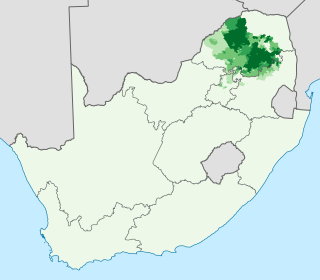| Northern Sotho | |
|---|---|
| Sesotho sa Leboa | |
| Native to | South Africa |
| Region | Gauteng, Limpopo, parts of Mpumalanga |
| Ethnicity | Pedi
Lobedu Pulana Tlôkwa |
Native speakers | 4.7 million (2011 census)[1] 9.1 million L2 speakers (2002)[2] |
Early forms | Tswaniac
|
Standard forms | Pedi |
| Latin (Northern Sotho alphabet) Sotho Braille Ditema tsa Dinoko | |
| Signed Northern Sotho | |
| Official status | |
Official language in | |
| Regulated by | Pan South African Language Board |
| Language codes | |
| ISO 639-2 | nso |
| ISO 639-3 | nso |
| Glottolog | pedi1238 Pedi |
S.32,301–304[3] | |
| Linguasphere | 99-AUT-ed |
 Geographical distribution of Northern Sotho in South Africa: proportion of the population that speaks a form of Northern Sotho at home.
0–20%
20–40%
40–60%
60–80%
80–100% | |
 Geographical distribution of Northern Sotho in South Africa: density of Northern Sotho home-language speakers.
<1 /km²
1–3 /km²
3–10 /km²
10–30 /km²
30–100 /km²
100–300 /km²
300–1000 /km²
1000–3000 /km²
>3000 /km² | |
| Pedi | |
|---|---|
| Person | Mopedi |
| People | Bapedi |
| Language | Sepedi |
Sesotho sa Leboa is a Sotho-Tswana language group spoken in the northeastern provinces of South Africa, most commonly in Mpumalanga, Gauteng and the Limpopo provinces.[4] It is also known by Pedi or Sepedi and holds the status of an official language in South Africa.[5][6]
An official language for the Lebowa homeland during apartheid, it is the first language of over 4.6 million (9.1%) people according to the South African National Census of 2011, making it the 5th most spoken language in South Africa.
- ^ Northern Sotho at Ethnologue (18th ed., 2015) (subscription required)
- ^ Webb, Vic. 2002. "Language in South Africa: the role of language in national transformation, reconstruction and development." Impact: Studies in language and society, 14:78
- ^ Jouni Filip Maho, 2009. New Updated Guthrie List Online
- ^ "NORTHERN SOTHO - South African Language Sepedi". www.sa-venues.com. Retrieved 8 June 2021.
- ^ "The SA Constitution". www.justice.gov.za. Retrieved 18 September 2023.
- ^ "free online course". www.unisa.ac.za. Retrieved 18 September 2023.